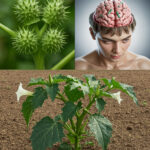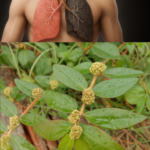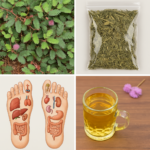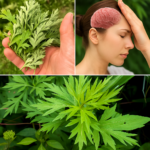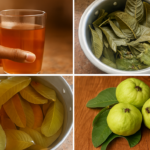The plant in question is both captivating and perilous; its beauty masks a dark reality. Datura, widely known as jimsonweed, holds an alluring charm that entices many to explore its potential. However, it carries a reputation that loudly declares how datura dangerous can be if approached without knowledge and caution. With its striking flowers and rich history, this enigmatic plant warrants a closer examination.

An Introduction to Datura
Datura is a fascinating member of the Solanaceae family, which includes several well-known plants like tomatoes and potatoes. This genus encompasses various species that are recognized for their unique characteristics and toxic nature. Often admired for their trumpet-shaped flowers that bloom in shades of white, purple, or yellow, many unwittingly overlook the dangers lurking within the plant’s leaves, seeds, and roots.
In this section, we will delve into the overview of Datura and its natural habitat, setting the stage for understanding why this plant is both cherished and feared.
Overview of the Plant
Datura’s aesthetic appeal cannot be denied. Its large, fragrant flowers unfurl like elegant trumpets in gardens and wild landscapes alike. However, what captivates the eye also serves as a warning. The allure of Datura has resulted in its cultivation across numerous regions, often leading to hazardous consequences for those unaware of its toxicity.

Originating from regions spanning North America to South America, parts of Asia, and Europe, Datura has adapted to different environments. Despite its geographical versatility, it thrives best in sunny locations with well-drained soils. It can be found growing in roadside ditches, fields, and even neglected gardens, making it readily accessible to those unfamiliar with its properties.
Natural Habitat and Distribution
Datura grows well in disturbed areas, often taking advantage of human-altered landscapes. The plant flourishes in environments that provide ample sunlight and moderate moisture levels. In urban settings, it may pop up unexpectedly—an overlooked beauty amidst concrete and asphalt.
Its ability to thrive in such diverse conditions raises awareness about how the datura dangerous plant can inadvertently become a part of everyday life. As a result, individuals may unknowingly encounter it while enjoying outdoor activities, gardening, or simply exploring nature.
The Toxicity of Datura
Understanding the inherent dangers of Datura requires a deeper examination of its chemical composition. The plant contains several tropane alkaloids, most notably atropine, scopolamine, and hyoscyamine. These compounds contribute to the toxicity and psychoactive effects associated with Datura, elevating its status from a mere curiosity to a serious health risk.
This section will explore the structure and effects of these alkaloids, shedding light on why even small amounts of Datura can lead to severe consequences.
Understanding Tropane Alkaloids
Tropane alkaloids are a group of chemical compounds that have significant physiological effects on humans. When ingested, they primarily influence the central nervous system and can lead to various reactions. Atropine, for instance, is known for its ability to dilate pupils and increase heart rates, while scopolamine has sedative properties that can induce sleepiness or confusion.
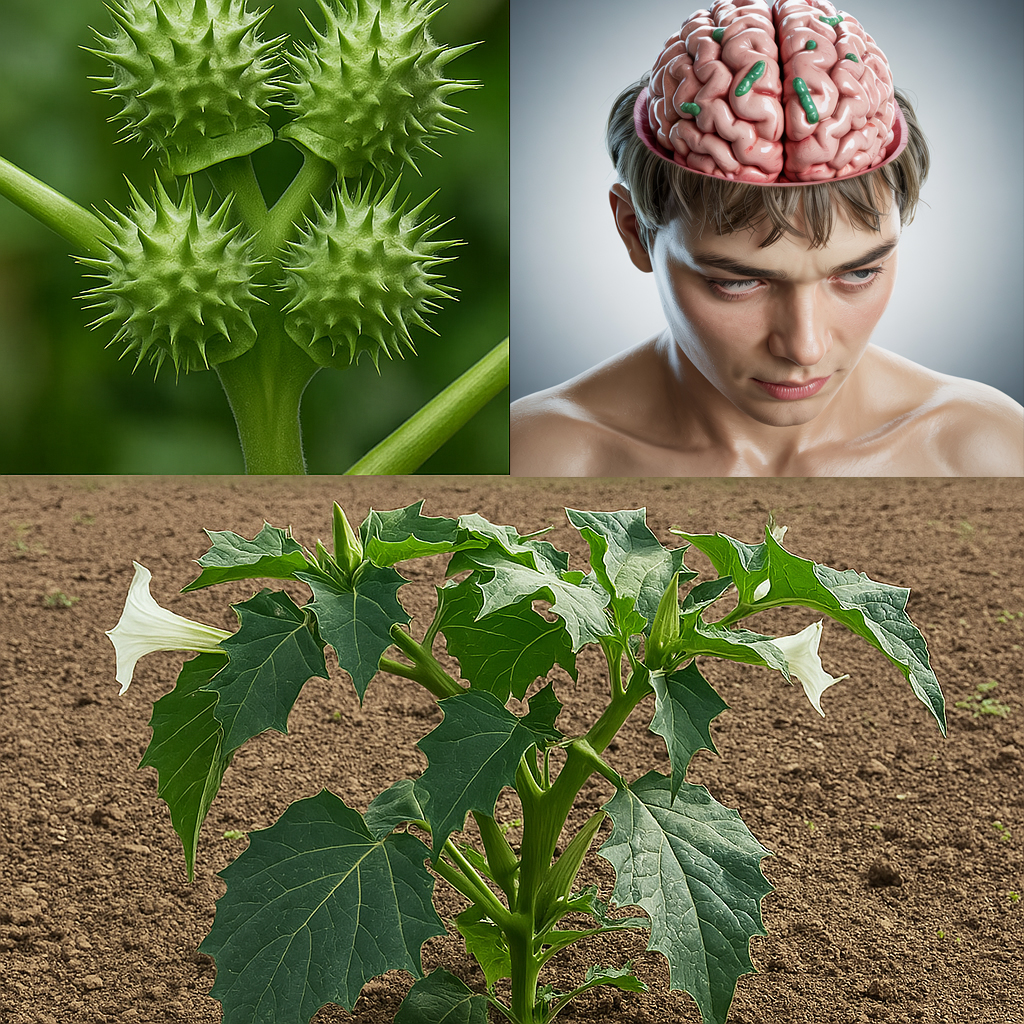
The presence of these compounds makes Datura particularly treacherous. Unlike common medications derived from similar sources, the dosages in Datura are unpredictable. This variability increases the risk of unintended poisoning, especially among those who may seek out the plant for its hallucinogenic qualities.
Effects of Poisoning
When consumed, the effects of Datura can escalate rapidly. Initial symptoms may include dryness of the mouth, thirst, and dilated pupils. However, as the toxicity progresses, users may experience confusion, agitation, hallucinations, and even delirium. The unpredictable nature of these effects marks Datura as uniquely dangerous compared to other psychoactive substances.
Severe cases can result in respiratory failure, coma, or death. For individuals seeking recreational use, the shift from euphoria to danger can happen alarmingly fast. Thus, engaging with Datura’s potent chemistry demands respect and awareness due to its potential to disrupt reality and induce a state of chaos.
Symptoms of Datura Exposure
Recognizing the symptoms of Datura exposure is crucial for ensuring safety. Due to its potent effects, anyone who encounters Datura should be prepared for the signs of toxicity. Symptoms often manifest in a variety of ways, creating a complex picture that can confuse even seasoned healthcare professionals.
Common early indicators include confusion, disorientation, and changes in visual perception. Victims may find themselves unable to differentiate between dreams and reality, resulting in frightening episodes of paranoia or aggressive behavior. Additionally, physical symptoms like rapid heart rate, flushed skin, and difficulty breathing could indicate a medical emergency requiring immediate attention.
Historical Context and Cultural Significance
The journey of Datura through human history reveals a complex relationship marked by both reverence and caution. Throughout various cultures, Datura has been utilized for its medicinal properties, spiritual significance, and ritualistic practices.
However, this historical context also highlights the perils associated with its use. The stories of ancient civilizations intertwine with contemporary experiences, demonstrating how the plant’s allure continues to captivate and endanger people.
Traditional Uses of Datura
Various indigenous cultures have embraced Datura for centuries, harnessing its properties for medicinal and ceremonial purposes. For example, some Native American tribes have employed Datura in rituals designed to facilitate communication with the spirit world or induce trance-like states.
Despite the plant’s intriguing role in traditional medicine, it’s essential to consider the duality of these practices. While some cultures revered Datura for its healing abilities, others experienced devastating outcomes due to misuse or unregulated consumption. This paradox illustrates the broader narrative of how humanity interacts with nature—seeking both the beneficial and the perilous.
Spiritual Practices Involving Datura
Datura’s ties to spirituality extend beyond mere medicinal uses. Many cultures regard the plant as a sacred entity, often incorporating it into religious ceremonies and rites. Some practitioners believe that Datura can elevate conscious experiences, enabling individuals to transcend ordinary perceptions of reality.
While these beliefs highlight the plant’s cultural significance, they simultaneously raise ethical concerns regarding its use. Spiritual contexts can sometimes obscure the inherent risks associated with Datura, leading some individuals to dangerously misinterpret its effects. Consequently, the line between spiritual enlightenment and perilous intoxication becomes blurred, contributing to ongoing discussions about the responsible use of psychoactive substances.
The Fine Line Between Medicine and Misuse
As we delve deeper into the world of Datura, it becomes increasingly clear that the transition from medicinal use to recreational misuse is fraught with challenges. Exploring the motivations behind Datura consumption sheds light on the various pathways individuals might take when approaching this complex plant.
This section will examine how perceptions of pain relief may clash with the allure of psychoactive experiences, ultimately leading to instances of misuse that carry serious repercussions.
Pain Relief Versus Psychoactive Effects
Throughout history, Datura has garnered attention for its analgesic properties. Traditional healers have used it to alleviate pain and discomfort, providing a natural alternative to synthesized pharmaceuticals. However, the plant’s psychoactive effects present a challenge for those seeking relief.
Individuals may initially turn to Datura for its therapeutic benefits, only to find themselves drawn into a web of hallucination and confusion. The temptation of altered consciousness can overshadow the original intent, blurring the lines between medicinal use and reckless experimentation.
Case Studies of Misuse
Real-life experiences illustrate the troubling trajectory from medicinal use to dangerous misuse. Numerous case studies document instances where individuals, believing they could safely engage with Datura for its psychoactive properties, found themselves spiraling into states of panic, confusion, or hospitalization.
One poignant example involves an individual who sought out Datura in pursuit of a euphoric high. What began as an innocent exploration devolved into terrifying hallucinations and a complete disconnect from reality. Ultimately, this case serves as a stark reminder that even seemingly harmless intentions can have catastrophic consequences when dealing with such a potent plant.
Misidentification and Garden Hazards
One of the more insidious aspects of Datura’s danger lies in the misidentification of the plant. Many gardeners may unknowingly cultivate it alongside non-toxic varieties, inviting risk into their homes without realizing it.
This section will explore how confusion with similar species, particularly Brugmansia, can lead to severe consequences for inexperienced gardeners and homeowners.
Confusion with Brugmansia
Often mistaken for Datura, Brugmansia is another member of the nightshade family that features stunning trumpet-shaped flowers. While visually similar, Brugmansia is regarded as less toxic than Datura, leading to misconceptions that can prove deadly.
Gardeners who admire the lovely blooms of Brugmansia may inadvertently invite Datura into their yards. The close resemblance creates risks, particularly for those who lack knowledge about identifying the subtle differences between the two. Mislabeling or misunderstanding these plants can expose unsuspecting individuals, children, and pets to the dangers of datura dangerous.
Risks for Inexperienced Gardeners
Gardening enthusiasts may fall victim to the allure of Datura, seduced by its striking flowers and exotic appeal. Unfortunately, many lack the expertise needed to identify the plant accurately or understand its hazards.
Without proper knowledge, individuals might propagate Datura in their gardens, allowing it to flourish unchecked. Children, curious by nature, may be inclined to touch or taste the plant, leading to potentially life-threatening situations. Such scenarios underscore the need for education on identifying and managing dangerous plants, fostering safer gardening practices.
Online Discussions and Anecdotes
The advent of social media has sparked conversations around the experiences of individuals who unwittingly encountered Datura. Platforms like Reddit feature threads dedicated to sharing personal anecdotes of discovery, misidentification, and even poisonings.
These discussions reveal the critical need for awareness and education about the plant’s identity and toxicity. Personal stories serve as cautionary tales, amplifying the message that beauty does not guarantee safety. By sharing these narratives, community members contribute to a collective understanding of the risks associated with Datura while advocating for responsible gardening practices.
The Hallucinogenic Properties of Datura
Datura’s notorious reputation as a hallucinogen has captivated individuals throughout history. Its capacity to induce vivid and often frightening hallucinations places it within a unique category of psychoactive substances.
Here, we will delve into the mechanisms behind Datura’s effects on the brain and explore user experiences that underscore the dangers involved in utilizing the plant for its hallucinogenic properties.
Mechanism of Action on the Brain
Understanding how Datura exerts its powerful influence begins with examining its interaction with neurotransmitter receptors. The tropane alkaloids found in Datura target the muscarinic acetylcholine receptors in the brain, hijacking normal neural pathways. This disruption can lead to altered perceptions, heightened sensory experiences, and profound dissociation from reality.
As Datura enters the bloodstream, its effects can vary significantly based on factors such as dosage, method of consumption, and individual tolerance. Users may find themselves engulfed in surreal landscapes or experiencing auditory and visual disturbances that can quickly spiral into terrifying scenarios.
User Experiences and Consequences
The narratives shared by Datura users paint a haunting portrait of the unpredictability surrounding its hallucinogenic properties. While some recount fleeting moments of euphoria, others detail harrowing experiences marked by anxiety, fear, and despair.
Consider the story of an individual who sought to escape reality through Datura, only to find themselves trapped in a nightmare of their own creation. Hallucinations morphed into paranoia and overwhelming dread, leaving them questioning their sanity. These personal accounts serve as reminders of the thin line between exploration and danger, further underscoring the need for responsible engagement with such substances.
Public Health Implications
From a public health perspective, the dangers posed by Datura represent significant implications for communities and healthcare systems alike. The plant’s accessibility and toxic properties create unique challenges that demand proactive measures to mitigate risks.
This section will address the importance of raising awareness about Datura’s dangers, particularly among vulnerable populations, and emphasize the role healthcare providers play in diagnosing and treating exposure.
Accessibility and Risk Factors
Datura is readily available in various environments, from gardens to wild spaces, increasing the likelihood of unintentional exposure. This accessibility heightens risks, particularly among children who may mistakenly ingest seeds or parts of the plant, believing them to be harmless.
As awareness regarding Datura’s dangers increases, so too must efforts to educate the public about identifying and avoiding the plant. Initiatives could focus on providing resources for families, schools, and community organizations to empower individuals with knowledge that could prevent exposure and accidents.
Importance of Education and Awareness
Educational initiatives aimed at raising awareness about Datura’s toxicity could be instrumental in reducing incidents of poisoning. Informational campaigns targeting specific demographics—such as parents, educators, and healthcare professionals—can foster greater understanding of how to manage encounters with potentially dangerous plants.
By emphasizing the message that beauty does not equate to safety, communities can cultivate a culture of vigilance regarding plant interactions, reducing the likelihood of tragic misunderstandings.
Role of Healthcare Providers in Diagnosis
Healthcare providers play a crucial role in addressing potential Datura exposure. Familiarity with the plant’s symptoms and effects ensures that medical professionals can provide accurate diagnoses and appropriate treatment for affected individuals.
As Datura’s symptoms often mimic those of other medical conditions, maintaining awareness about its potential presence in patients’ histories is vital. Educating healthcare providers about the substance will help promote prompt recognition and intervention, ultimately safeguarding patients from the harmful effects of Datura.
Preventative Measures and Safety Tips
Navigating the dangers posed by Datura necessitates a proactive approach. Understanding how to identify the plant, as well as implementing safe gardening practices, can significantly reduce risks associated with Datura exposure.
This section will share practical tips for recognizing Datura in the wild and offer guidelines for cultivating a safer gardening environment.
Identifying Datura in the Wild
Knowing how to identify Datura in its natural habitat is essential for minimizing exposure risks. Key characteristics include its large, trumpet-shaped flowers, jagged leaves, and spiky seed pods. The flowers may range in color from white to purple or yellow, depending on the species.
Additionally, being aware of Datura’s growth habits can aid in identification. The plant typically grows tall, often reaching heights of 3 to 4 feet, and can thrive in disturbed areas. Observing these traits will equip individuals with the necessary knowledge to avoid encounters with this dangerous plant.
Safe Gardening Practices
For those who wish to cultivate beautiful gardens while avoiding Datura, adopting safe gardening practices is paramount. Proper research and planning can help ensure that only non-toxic species grace your garden.
Consider options such as consulting local horticulturalists or joining gardening forums focused on safe plant choices. Establishing a network of knowledgeable peers can provide insight into distinguishing Datura from lookalikes, empowering gardeners to make informed decisions.
Legal Status and Regulations
The legal status of Datura varies worldwide, reflecting different cultural perspectives and approaches to managing its risks. Understanding these regulations can illuminate the complexities surrounding the plant’s usage and cultivation.
This section will explore the legal landscape concerning Datura in various countries, highlighting implications for those interested in using or growing the plant.
Datura in Different Countries
In some nations, the cultivation and possession of Datura are regulated due to its toxic properties. Laws often reflect concerns regarding public health and safety, emphasizing the need for awareness and education related to the plant’s dangers.
Conversely, certain cultures continue to embrace Datura for its traditional medicinal and spiritual uses. Legal frameworks in these regions may allow for regulated use while striving to balance cultural practices with health considerations. This dichotomy illustrates the ongoing tension between appreciation for nature’s gifts and acknowledgment of their potential risks.
Implications for Usage and Cultivation
The varied legal statuses surrounding Datura underscore the importance of understanding regional regulations before considering its use or cultivation. Those interested in Datura must navigate a complex landscape that weighs cultural significance against public health imperatives.
Exploring these implications can enhance awareness and foster dialogue around responsible practices while respecting traditional uses. Engaging in community discussions can further enrich understanding and infuse cultural context into conversations about safety and education.
Datura in Popular Culture
Datura’s enigmatic nature has left its mark on popular culture, appearing in literature, art, and media representations. The plant’s association with beauty, danger, and altered states of consciousness resonates with artists and storytellers alike.
This section will examine how Datura has influenced creative expressions and shaped public perceptions of the plant’s allure and perils.
Literature and Art Depictions
In literature, Datura often serves as a symbol of beauty intertwined with danger. Writers frequently explore themes of enchantment, madness, and the costs of pursuing heightened experiences. Classic works may depict characters ensnared by the intoxicating effects of Datura, illustrating the seductive pull of the plant while serving as cautionary tales.
Similarly, artists have captured the essence of Datura in their work, infusing visuals with both fascination and foreboding. The contrast between the plant’s stunning appearance and its lethal potential offers fertile ground for artistic interpretation, inviting viewers to grapple with the duality of nature.
Media Representation of Datura Experiences
With the rise of digital media, Datura’s portrayal has broadened, encompassing personal anecdotes shared through blogs, videos, and social media platforms. These narratives reveal the complex relationships individuals form with the plant, showcasing both admiration and apprehension.
Media representations can serve as valuable educational tools, fostering awareness of Datura’s risks and encouraging responsible engagement. However, they may also perpetuate romanticized notions of the plant, blurring the lines between exploration and recklessness. It’s essential to approach these portrayals critically, recognizing the nuance required in discussions about such a potent substance.
Conclusion
In conclusion, Datura stands as a testament to nature’s complexity—a beautiful yet dangerous plant that embodies the intricate dance between allure and peril. From its striking flowers to the hallucinogenic properties within its leaves and seeds, the datura dangerous narrative echoes throughout history, culture, and public health discourse.
As we navigate our relationship with Datura, we must prioritize education, awareness, and responsible engagement. By understanding its risks and celebrating the beauty of nature responsibly, we honor the delicate balance between attraction and caution, ensuring that encounters with Datura are informed and safe.
